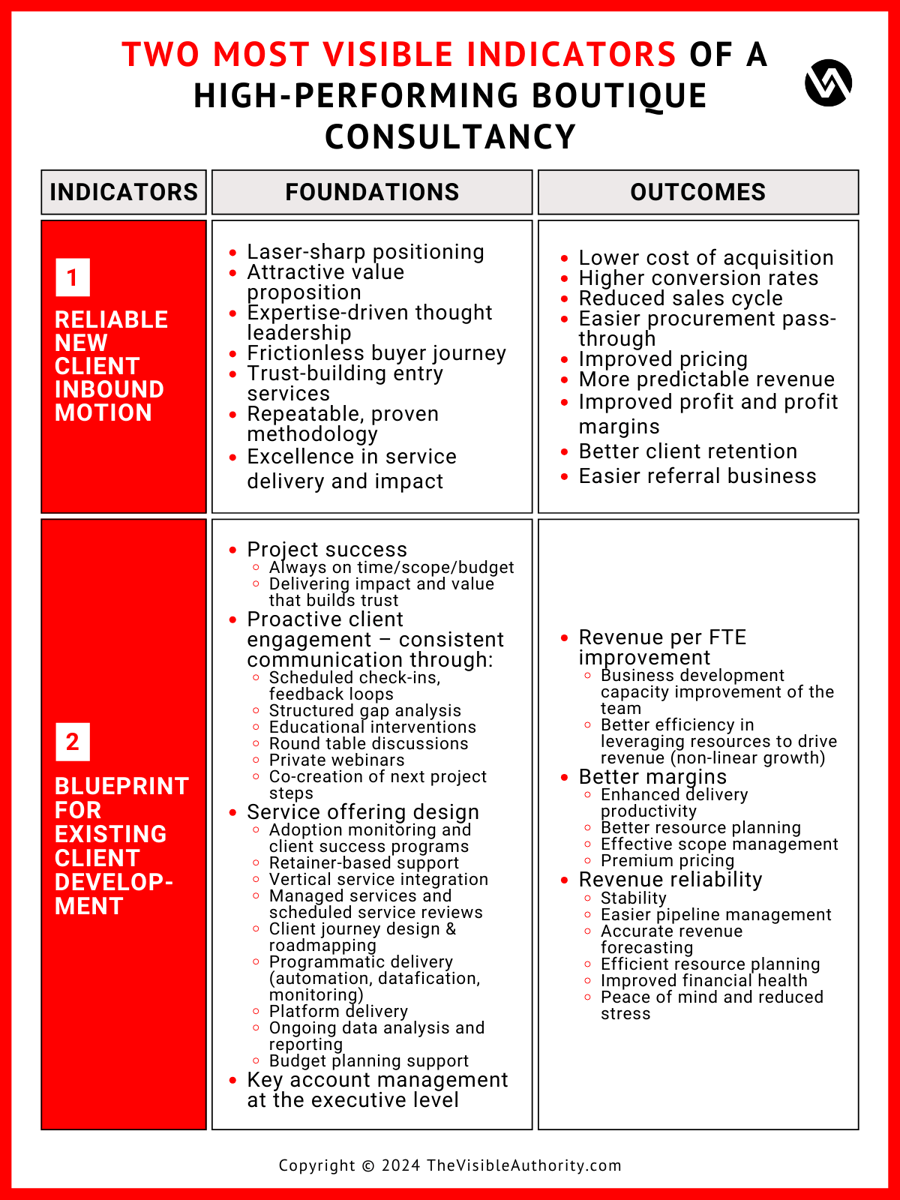
The Two Most Visible Indicators of a High-Performing Boutique Consultancy

I work with owner-led, mid-size boutique consultancies. It’s my area of expertise. It’s to what I dedicate every single minute of my work time. I audit them, I learn from them, I read articles and studies, I write blog and LinkedIn posts about these types of consulting firms, and I guest-host webinars on this subject.
I identify problem areas, audit foundational elements, help build roadmaps, distill lessons learned from high-performing consultancies into actionable advice – all of this results in a giant pool of data and knowledge. Over time, patterns reveal themselves.
One such pattern that I’ve observed is that consultancy performance can be distilled into two dominant, extremely visible indicators. These high-performing consultancies have:
- A reliable new client inbound motion - to fuel growth
- A well-built blueprint for existing client development - to fuel stability
Surprising in their simplicity yet transformative implications, these outcomes are the essence of consultancy excellence.
That’s what I’ll be delving into in this article.

1. A reliable new client inbound motion of high-performing boutique consultancies
Isn’t it the ultimate dream of every consultancy: having clients come to it rather than constantly chasing new leads?
It signifies its expertise reputation, its ability to provide problem resolutions that resonate with its target audience. It's a sign of trust and value, making it crucial for sustained success.
High-performing consultancies excel at inbound motion. I am always amazed at the precision and effectiveness of inbound client acquisition that high-performing boutique consultancies display.
I’ve been keeping track of all the foundational elements these consultancies share as well as the indicators that show the impact of their new client inbound motion. After months (though, more like 2+ years) of this exercise, I have narrowed down them down to the ones that I see in practically every single instance of a high-performing boutique consulting firm.
The foundations of the inbound motion
- Laser-Sharp Positioning: A consultancy's ability to clearly define its expertise domain and target audience is fundamental. Laser-sharp positioning ensures that the consultancy addresses the specific needs of its ideal clients.
- Attractive Value Proposition: An irresistible value proposition showcases what sets the consultancy apart and why clients should choose it over competitors. It communicates the unique benefits and solutions offered.
- Expertise-Driven Thought Leadership: By openly sharing problem-resolution expertise consistently, actively engaging with the audience, and providing valuable insights, consultancies build credibility and trust.
- Frictionless Buyer Journeys: Streamlined, user-friendly buyer journeys make it easy for potential clients to engage with the consultancy. Simplicity is paramount.
- Trust-Building Entry Services: Offering entry or discovery services that are both appealing and confidence-building can lead to long-lasting client relationships. These services provide a glimpse into the consultancy's expertise.
- Repeatable, Proven Methodology: A well-defined and repeatable methodology with predictable outcomes is reassuring to clients. It showcases the consultancy's ability to deliver results consistently.
- Excellence in Service Delivery & Impact: Proven by outcome-based client testimonials, service excellence is a testament to the consultancy's commitment to client success. These testimonials provide social proof and build trust.
Recommended reading: (Case Study) Replicate the Secret of This Highly Profitable Consultancy
The outcomes of new client inbound motion
A strong inbound motion in a consultancy is typically characterized by several key outcomes that have both immediate and long-term impacts on performance. Here is the main impact of a strong new client inbound motion that I’ve experienced in the past years:
- Lower Cost of Acquisition (CAC): A strong inbound motion always leads to a significantly lower CAC as clients proactively seek the consultancy's services. This ‘no-need-to-chase-new-clients’ results in substantial cost savings and improved profitability.
- Higher Conversion Rates: Inbound leads are more likely to convert into new clients, leading to higher conversion rates than any other outbound method I know of.
- Reduced Sales Cycle: Inbound clients typically have shorter sales cycles as they are already interested and engaged with the consultancy's content and offerings. ‘Let’s get this started’, I got told many times.
- Easier Procurement Pass-through: Inbound clients often require less convincing during the procurement process, leading to smoother and more straightforward assessments and saving time and resources (leading to the reduced sales cycle).
- Improved Pricing: Clients attracted to the problem-resolution expertise of the consultancy may be more willing to accept premium prices for consultancy services, resulting in improved average deals and higher profitability.
- More Predictable Revenue: A strong inbound motion provides a higher level of predictability of future revenue streams, making financial planning and resource allocation more manageable and creating a higher degree of stability in the consultancy (and in the head of its leaders).
- Improved Profit & Project Margins: With lower acquisition costs, a higher proportion of converted leads, better pricing, and enhanced average deals, consultancies can enjoy improved gross margin and net profit.
- Better Client Retention: Inbound clients tend to be more satisfied and loyal, leading to higher client retention rates, the starting point for the ‘existing client development motion’ (will be the next post).
- Easier Referral Business: Satisfied inbound clients are more likely to refer new business, further contributing to new client acquisition and revenue growth.
These indicators - to name a few from my experience in the past years - collectively contribute to the overall performance of a consultancy. While some results may be immediate, others may take time to fully materialize though.
I’ve been there in the iNostix/Deloitte years: our strong inbound motion was the ultimate foundation for high-margin, predictable revenue.
2. A well-built blueprint for existing client development at high-performing boutique consultancies
I advise the 30/70 ambition consultancies should target:
- 30% of the revenue from new clients - inbound - to fuel growth
- 70% of the revenue from developing existing clients - to fuel stability
I always clarify that this is not an exact science. Rather, it’s something that I recommend boutique consultancies aspire to.
Why? Because it puts revenue stability and predictability first. At the same time, targeting around 30% of revenue to come from new clients means keeping the service offering fresh, keeping the prices competitive, generating new success stories, and safeguarding the pipeline from going stale.
Just like with new client inbound motion, I have noticed that high-performing boutique consultancies share foundational elements and indicators when it comes to developing the relationships with existing clients.
Recommended reading: How to Balance Hunting and Farming for Sustainable Consulting Growth
The pillars for sustained existing client development
- Project Success: It all starts with ongoing project success, the heart of retaining existing clients and opening the door for continued development. It goes beyond meeting deadlines, scope and budgets. It's about delivering value and impact that build trust and advance the client journey, paving the way for ongoing collaboration.
- Proactive Client Engagement: Client retention and development requires proactively fostering client engagement by maintaining consistent communication through regular check-ins, feedback loops, and project updates. Enhancing the relationship by conducting structured gap analysis sessions to understand evolving challenges.
Consultancies may want to consider offering educational interventions, facilitating open round table discussions, and hosting private webinars on relevant topics such as market trends and new technologies. Other best practices I’ve observed are involving clients in co-creating upcoming project steps and providing support in implementing client success programs to ensure a holistic approach to the client’s problem resolution. - Service Offering Design: One of my favorite approaches is offering additional value-added services or solutions that align with existing clients' evolving needs and delivering value over an extended period (vs one-off, short-term projects). It includes implementing strategies such as ongoing adoption monitoring and corrective interventions, introducing subscription-based or retainer-based support models, vertical service integration (solutions that span from broad strategic advice to highly specialized, granular interventions), implementing managed services, strategic CXO guidance, scheduled service reviews, roadmap and client journey design, programmatic delivery (automation, datafication, monitoring), platform delivery, managed services, ongoing data analysis & reporting, and budget planning support (to name a few).
- Key Account Management: Experienced key account management focusing on developing trusted partnerships at the executive or C-level (high ‘altitude of involvement’) because that’s where the best client development happens. This is a crucial role for the consultancy owner(s), partners or leaders.
Research by Source underpins the importance of account management.- It found that 45% of clients end up spending more on individual projects due to the influence of their account manager.
- Furthermore, 54% of clients commissioned extra work due to great account management.
- Finally, 71% of clients receiving legal services ended association with their service provider due to poor account management.
These findings show both the tremendous potential of good account management and the serious risks of poor/inexistent account management.
The outcomes of the sustained existing client development
If consultancies excel at developing existing clients over an extended period, in my experience, these outcomes become visible consistently:
- Revenue per FTE improvement:
- Business development capacity improvement of the team
- Better efficiency in leveraging resources to drive revenue (non-linear growth)
- Better margins: Long-term client development is a key strategy for improving project margins in consulting firms. Here’s how it makes a difference:
- Enhanced Delivery Productivity: Familiarity with client needs and processes streamlines workflow, reducing the need for onboarding and increasing efficiency.
- Better Resource Planning: Understanding the client's future needs allows for more precise allocation of the right talent, minimizing downtime and underutilization.
- Effective Scope Management: Long-standing relationships, in my experience, facilitate clearer communication, helping to manage project scope and avoid unnecessary scope creep.
- Premium Pricing: The trust and value established over time enable firms to negotiate (or maintain) higher rates for specialized services.
- Enhanced Delivery Productivity: Familiarity with client needs and processes streamlines workflow, reducing the need for onboarding and increasing efficiency.
- Revenue reliability: Revenue reliability plays a crucial role in the stability and growth of consulting firms. It ensures consistent performance through:
- Stability: Predictable revenue streams provide a solid foundation, reducing volatility and enhancing business resilience.
- Easier Pipeline Management: Knowing what revenue to expect simplifies managing the sales pipeline and prioritizing efforts.
- Accurate Revenue Forecasting: Reliable revenue makes it easier to project future earnings, aiding in strategic decision-making.
- Efficient Resource Planning: With predictable revenue, firms can allocate resources more effectively, matching workforce planning with anticipated projects.
- Improved Financial Health: Consistent revenue flow supports better cash flow management, investment in growth opportunities, and financial planning.
- Peace of Mind and Reduced Stress: The assurance of steady revenue alleviates the pressure of constantly needing to chase new clients, leading to a more stable work environment and better quality of life for all involved.
- Stability: Predictable revenue streams provide a solid foundation, reducing volatility and enhancing business resilience.
Recommended reading: 10 Consulting Trends: 2024 Edition
In conclusion
High-performing consultancies are not born. They are carefully crafted. They are operating at maximum efficiency. Like a Swiss clock, they are precise in everything they do.
However, it doesn’t happen overnight. Every high-performing boutique consultancy has to go through the laborious process of setting up the initial business, determining the narrow market, and deepening the expertise to the point where it can provide transformational value to clients. Every single one had to build up a library of authoritative content and social proof in the form of case studies and testimonials.
The ones who made it to the top? They are the ones that understand how the buyers’ market and purchasing habits have evolved, and actively incorporate it in their client acquisition and client retention strategies. They understand that to achieve these fantastic levels of success, they need to stand out, they need to be known for exceptional expertise, and they need to maintain a healthy balance between nurturing existing clients and continuously acquiring new ones at low cost.
Interested in receiving all my learnings to become a better consultant? No spam, no BS. Pure teaching! Subscribe to my newsletter.

Luk’s extensive career in the consulting business, which spans more than 20 years, has seen him undertake a variety of influential positions. He served as the European CHRO for Nielsen Consulting (5,000 consultants in the EU), founded iNostix in 2008—a mid-sized analytics consultancy—and led the charge in tripling revenue post-acquisition of iNostix by Deloitte (in 2016) as a leader within the Deloitte analytics practice. His expertise in consultancy performance improvement is underlined by his former role on Nielsen's acquisition evaluation committee. After fulfilling a three-year earn-out period at Deloitte, Luk harnessed his vast experience in consultancy performance improvement and founded TVA in 2019. His advisory firm is dedicated to guiding consulting firms on their path to becoming high-performing firms, drawing from his deep well of consulting industry expertise and financial acumen.

